
|

|
Forum Index : Electronics : Rotten cables....
| Author | Message | ||||
| BenandAmber Guru Joined: 16/02/2019 Location: United StatesPosts: 961 |
By the way all the safety stuff including ground fault interrupter is grounding Wire nuts are insulators not fasteners good connections the right size wire for the run and the load and all connections being in a box which anyone can do piece of paper doesn't change that If you're unsure of something always take the side of precaution and look it up Be wary of electrician the never ever looks anything up be warned i am good parrot but Dumber than a box of rocks |
||||
| Boppa Guru Joined: 08/11/2016 Location: AustraliaPosts: 814 |
Pigtails is a US 'thing', Au/NZ don't require it, nor does the UK (personally I'm against it, it only adds more connections in the system, with the increased possibility of a connection going bad)- in Au/NZ the regs don't actually ban it but it is 'preferred' to minimise the number of connections on a circuit... Personally I'm not that keen on the UK ring system either, it saves on copper costs, but adds to the complexity of the install, and should a cable go O/C, depending on how it's wired (either dual breakers, one for each end of the ring, or more common in older systems, a single fuse or breaker feeding both ends of the ring), there is the possibility of overloading the cabling... Newer rings require the use of cables capable of carrying the full circuit current anyway (negating the need for the ring) but older installs used smaller lower current cabling and relied on the ring splitting the current through both legs back to the fuse/breaker... Should a break occur, there is the possibility of the full load being sent through a single underrated wire... not good... |
||||
| BenandAmber Guru Joined: 16/02/2019 Location: United StatesPosts: 961 |
It's the same amount of connections either way you either trust Twisted wire connections or a receptacle screw down connector That is if you take away the convenience of very easy troubleshooting a circuit be warned i am good parrot but Dumber than a box of rocks |
||||
Grogster Admin Group Joined: 31/12/2012 Location: New ZealandPosts: 9308 |
Test post... EDIT: Original post I have tried many times today to post: Yes, pigtails are not generally used in NZ. I expect that is the same in Australia, as we share the same code. (the AUS/NZ standard) 99% of most domestic single-phase installations have the TPE/T&E loop around all the outlets AT the outlet, so you have an incoming 'FEED' and an outgoing 'LOOP' to the next outlet. On the old fuse-based panels like I have here at home, there are generally about three outlets on any one feeder. The new regs I think require that outlets are split into two or three per MCB, and I think that nowadays those three outlets are also protected by an RCD. That would make sense. I know I have seen configurations like that in new houses that they build. This does make for a rather over-complicated main panel though, IMHO.... [Quote=Boppa]Re the extra cabling to light switches, it's been required for a while for all lighting circuits to have the earth fitted (so TPE, rather than twin) but it was the norm to chain at the bulb and just have a twin down to the light switch from the light fitting, now it's becoming the norm (especially with touch or smart switches becoming more common) to chain at the light switch ie TPE to the switch, and again up to the light fitting, with the chain to the next room coming from the switch rather than the light fitting... (if that makes sense)[/Quote] Yes, it does. This is how pretty much every lighting circuit I have seen over here works in a simple domestic MEN install. A feeder in, a loop out, and a third wire to the light fitting(or fittings). Also quite common to find a forth cable in the same box, if there is a 2way switching arrangement such as in a hallway, where you have a switch at each end of the hall, and either one can switch the hall lights on or off. Things get kinda crampt in THOSE boxes, if you are unlucky enough to have a single wall-plate with all that behind it!  My house, luckily, uses dual switch plates(double size ones) for the hallway 2-way and the two outside lights, so that gives me a bit more room to move!  Here is a shot of the wires at the double by the front door: 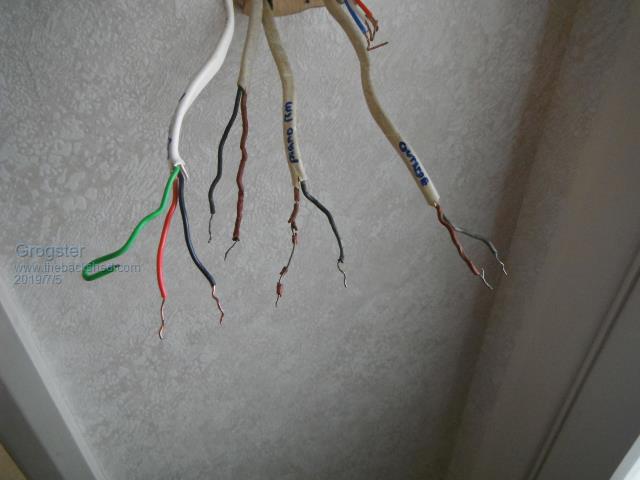 Nothing was labelled - I have been labelling as I find out where things went to. The labels are only to help me, as these cables will be used as draw-wires to pull in the new feeds. I am using 1.5mm T&E/TPE for the new runs, as I had a roll and a half of that on the shelf, so... But you can see how the twins at the switch end of things have also disintegrated when I touched them. You can also see a PVC T&E there, which is a feed to the lounge-room that was done years ago when some wall lights were added during the doing up of the lounge. The red/white/blue at the top of the image is also PVC, and is the 2way circuit back to the other door switch. The two rear-rooms also are wired in PVC, so I don't need to touch them, just the original rooms. EDIT: Yay! Gizmo has fixed the problem.  Smoke makes things work. When the smoke gets out, it stops! |
||||
| BenandAmber Guru Joined: 16/02/2019 Location: United StatesPosts: 961 |
From the sounds of it you're very educated with it and need no help for me But if I was your neighbor I would offer anyway be warned i am good parrot but Dumber than a box of rocks |
||||
Grogster Admin Group Joined: 31/12/2012 Location: New ZealandPosts: 9308 |
Oh, you're sweet!  Thanks.  I could use you, if you WERE my neighbour. You could help pull in some of the tricky ones.  Thankfully, I do have a helper coming to help me this weekend for the difficult runs. Pleas don't think we are raining on your parade. There are differences in regulations between USA and UK/AUSTRALIA/NZ. I can personally see the benefit of the pigtail things, but here in NZ, regulations require that we DON'T wire like that. Absolutely no offence to you, simply different standards.  Smoke makes things work. When the smoke gets out, it stops! |
||||
| lizby Guru Joined: 17/05/2016 Location: United StatesPosts: 3150 |
>I was told by the building inspector several years back that instead of two shielded conductors and a ground they are going to require 3 conductors and a ground Maybe this is a California thing. I've never seen it. What is the 3rd conductor for, and what is it attached to on both ends? How does this relate to the piece of sparky folk wisdom that I've heard: wire "hot" to the switch, not "hot" to the light? I've seen an electrician work on a light with a hot circuit but the switch off--a practice that horrified me. >all the electricians that care about what they're doing put Pigtails in I did some web searching and found a lot of disagreement over this, as well as differences in regional practice--even among electricians. It's clearly refuted that the outlets are unable to safely carry and pass on through the screw terminals the 20 amps that a 12-2 circuit might be able to provide to the 15A-rated individual sockets. Some say that in earthquake areas (hope nobody here was affected in California yesterday), the outlet screw terminals are less secure than wire nuts. Others say (without citing any actual studies) that wire nuts are as likely to fail as outlet screw terminals. (Everybody agrees that you shouldn't poke the wires into the back of the outlets.) I can certainly see the advantage of pigtails for trouble-shooting. Note I claim no expertise and don't have a dog in any fight that might relate to this. I'm just wondering what practice is now in North America, and why. PicoMite, Armmite F4, SensorKits, MMBasic Hardware, Games, etc. on fruitoftheshed |
||||
| Boppa Guru Joined: 08/11/2016 Location: AustraliaPosts: 814 |
Grogster- ugggh, yeah those cables are toast all right... Lizby- there are several differences between US outlets (here powerpoints or more officially GPO's)- we dont have 'pushins' or separated screw outlets, the wires are twisted together for mechanical strength then fitted to a single screw in clamp (Ocassionally you will find a pigtail fitted, but only where there are too many wires to go into the GPO 'holes' Australian GPO 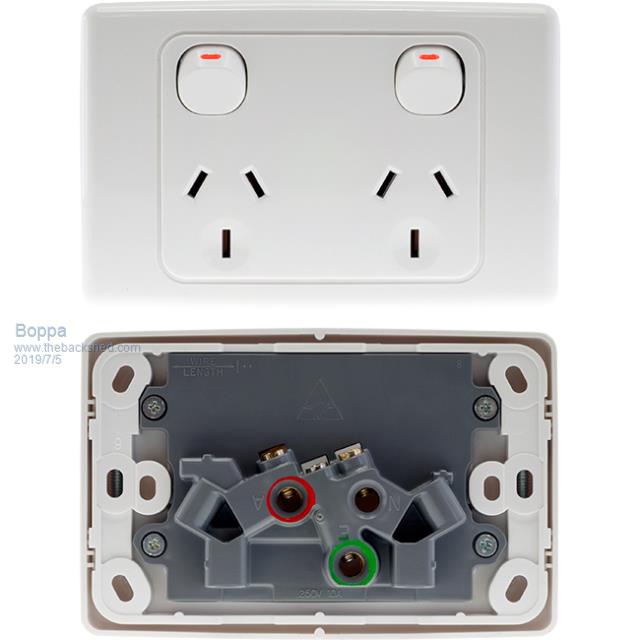 Re the 3 and ground, that's where they want a Active supply, switched Active to the lamp fitting, Neutral and Earth all at the switch (required for most IOT style smart switches) where previously they only had 3 per switch in newer installs (Active feed, Active switched and Earth) and older ones only had two (Active feed and switched Active to lamp... Old way, looped at light, 2 wire feed to switch... 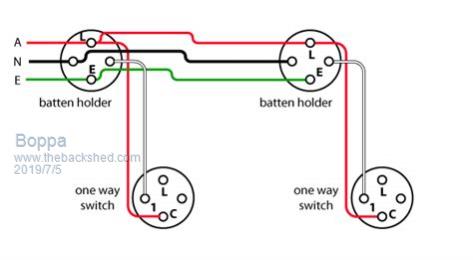 Newer way, looped at switch, '4 wire' or '3 conductor and ground' switching 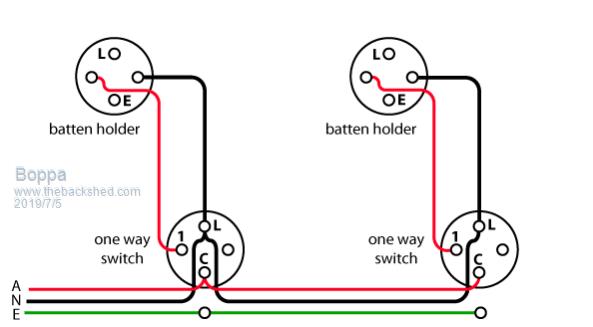 (note that diagram is incorrect in one respect- there should also be a green earth wire running to earth light fitting as well, that's required by law now) |
||||
| Boppa Guru Joined: 08/11/2016 Location: AustraliaPosts: 814 |
This is what it should be like (biggest advantage imho is its all in TPE- less rolls to carry around LOL)  Interesting too that wirenuts are in such common use in the States, I have never seen them used here, and quite frankly not sure if they would even pass inspection BP connectors are the norm in Australia  The single screw ones are used on A or N wires, the double screw ones are used for earth wires |
||||
| lizby Guru Joined: 17/05/2016 Location: United StatesPosts: 3150 |
Boppa--your last diagram would be the way I have always seen it in new installations in the U.S. and Canada (connectors are different, of course), and what I'd have called wired "hot to the switch". That's as opposed to your first diagram which is what I would have called "hot to the light" and which has not been allowed in new installations in the 40 years of experience that I have had (not as an installer)--in the locations I have known of--there may have been local variations. Still wondering what an additional connection to the "batten holder" would be for. PicoMite, Armmite F4, SensorKits, MMBasic Hardware, Games, etc. on fruitoftheshed |
||||
| Warpspeed Guru Joined: 09/08/2007 Location: AustraliaPosts: 4406 |
Fascinating stuff guys... I suppose the now unused batten holder loop connection would still be required if a batten holder in an old installation needed replacing. Cheers, Tony. |
||||
| Boppa Guru Joined: 08/11/2016 Location: AustraliaPosts: 814 |
'Hot to the light' is still allowed here (and indeed is the most common still in use) although 'hot to the switch' is preferable as it allows a lot more flexibility What additional connection? If you mean the L (loop) connection, it is exactly that- a unconnected terminal built into the fitting- basically a built in BP connector If you mean a fourth wire to the light fitting from the switch, I can think of several possibilities- especially as you lot don't do 'hot to the light'... One would be an unswitched Active to the light fitting (for running 'IOT' or 'intelligent' fittings that need power permanently) Another would be for an Active for a fan (The number of times I've wished they put in an extra wire for ceiling fans/ bathroom extractor fans etc) although I doubt that would be foremost in their minds- making things easy for the sparkies.... HA!!! Light switch with 'loop'/L connection (the partially blocked 2 is for 2 way (or 3 way as the yanks call it for some reason) switching ie a switch at each end of a hallway so the light can be turned on or off at either end- if you need to use it, just pop the blanking plate out with a screwdriver 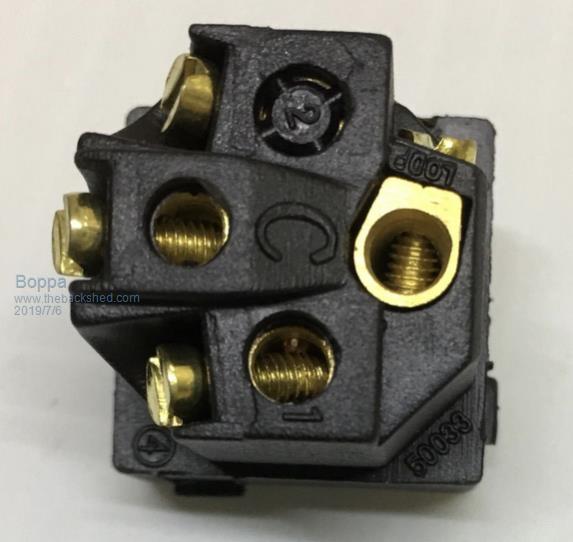 Same loop terminal is on light fittings 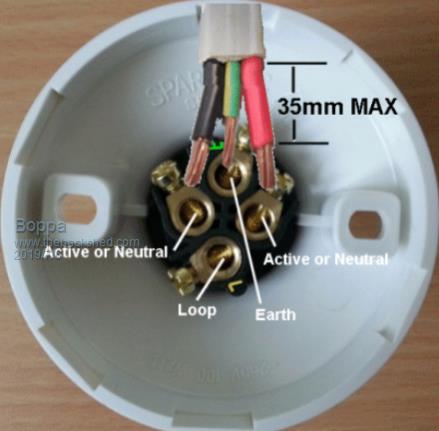 |
||||
| lizby Guru Joined: 17/05/2016 Location: United StatesPosts: 3150 |
The one Ben said an inspector told him would be required in the future But then why aren't you essentially back to "hot to the light" with a loop to the switch. I thought the purpose of "hot to the switch" was so that if the switch was turned off, there was no danger of electrocuting yourself when working on the light box (not that I personally would rely on that, being a belts and suspenders kind of guy). I'm with you there--the need I have seen was to put a fan and light in where there was just a ceiling light before--but another problem is that the box mounting is probably not sturdy enough to support the weight of a fan. PicoMite, Armmite F4, SensorKits, MMBasic Hardware, Games, etc. on fruitoftheshed |
||||
| BenandAmber Guru Joined: 16/02/2019 Location: United StatesPosts: 961 |
Boy I tell you what I think we're back to the same thing as the ways the United States measures stuff that does look like a lot safer and a lot better way of doing things Most of our light fixtures I have about 6 inches of generic stranded wire coming out of them And you're forced to use a wire nut as a fastener Needless to say I'm very impressed your guys's sockets look pretty cool to If you want to see something really ignorant look up mobile home style Outlets for the United States They have a sharp metal V that you don't skin The Wire before you put it in you just put it in and push it down and the V makes a connection with the copper after it cuts through the skin of The Wire They are notorious for coming loose a trailer is wired in such a way that wherever the shortest run to the next receptacle is that's where it goes you have no idea which way they was coming from with the wire so usually takes you awhile to figure out which socket is causing the problem be warned i am good parrot but Dumber than a box of rocks |
||||
| BenandAmber Guru Joined: 16/02/2019 Location: United StatesPosts: 961 |
A lady wanted me to come out and put a new receptacle in her living room I was trying to figure out the run that was closest to there and how many receptacles it had on it I noticed that they were still power on to the dishwasher all the 110 circuits are off Come to find out the guy had put a 220 breaker on that run had 220 coming to underneath the sink then split it off from there without no box no breaker or anything just used one leg to go one way the other leg to go another way 50 amp breaker be warned i am good parrot but Dumber than a box of rocks |
||||
Grogster Admin Group Joined: 31/12/2012 Location: New ZealandPosts: 9308 |
Hot to the fitting, and switching the load side is - IMHO - a death-trap. I was always taught that you ALWAYS switch the phase, and ALWAYS on the incoming feed. IE: NEVER switch the load side of the circuit, or the neutral. The idea being, that with the switch OFF, the circuit should be dead. Done the other way around, the lights will be off with the switch off, but the circuit is still live at the fittings - not good, if you are being a little careless and assume cos the switch is off, the power is off.... I guess my rule of 'Assume all conductors are live' works for any setup. Assume wires could be hot, even if you think they are not. That forces me to use fully insulated screwdrivers and pliers etc, and to avoid touching the wire itself whenever possible. Even with the fuses or MCB's out. Even if the main switch is off. That is possibly a case of being a little over-cautious, but rather that then dead.  Smoke makes things work. When the smoke gets out, it stops! |
||||
| Boppa Guru Joined: 08/11/2016 Location: AustraliaPosts: 814 |
Load side switching is pretty much the norm I have found- I suspect a combination of it's easier to wire, and uses less cable (admittedly requiring two different rolls) A lot of it might be the Au/NZ difference- here you isolate at the switchboard any time you pick up a tool, loadside switching is perfectly safe for users to change a bulb (which is pretty much all an aussie is allowed by law to do) and anything else (switch change/ fitting change etc) a sparky will isolate and test before working Yeah all my tools are isolated, and have their own toolbox, not in with the general tools- screwdrivers, side-cutters, pliers, spanners all full insu and checked, I also have a 'live wire' non contact tester as well after an incident many years ago (I still got the side-cutters somewhere) where I was repairing a 'hotpot' that was in a electric motor repairers workshop with brand new owner (hotpot is a solder dip tub electrically heated) It had stopped heating up (fixed wiring), killed the breakers and went to cut the wiring leading to the mains connect point after testing (no volts on meter) badly corroded screws so had to cut wires off, cut and 'SPLAT' hmmm side-cutters got a hole in them you can pass a 3" nail through... Turns out previous owner had started 'borrowing' electricity- it wasn't just bypassing the fuses, but the entire fusebox....- he had tapped into the line from the overhead feed point to the fusebox and hidden it under a beam- so the only breaker was the ones on the powerlines out the front (no idea what they are rated at, but a hell of a lot I assume) Was very professionally done at the joint- considering it must have been done 'live' but with absolutely no means of switching it off or circuit protection of any kind....  eta WOW... those 'scotchlock' style ones are dodgy as hell 'insulation displacement connectors'... I never use them, even in cars- because they always fail after a few years plus imho, they aren't safe at any current level, because you only have a couple of small 'contact points' connected to the wire (same as 'pushins' nope don't like em...) Here a caravan (or travel trailer  ) has it's own entire subsection in the Au/NZ electrical standards- all mains switching (GPO or lighting) must be DPST instead of the SPST required in household wiring- A and N MUST be switched... (finding people stocking DPST GPO's isn't the easiest- it's normally an 'order in') I had to reread the entire section a few years back when I was working at a place that did camper conversions/repairs because there is a lot of extra requirements before the compliance plate can be legally attached... ) has it's own entire subsection in the Au/NZ electrical standards- all mains switching (GPO or lighting) must be DPST instead of the SPST required in household wiring- A and N MUST be switched... (finding people stocking DPST GPO's isn't the easiest- it's normally an 'order in') I had to reread the entire section a few years back when I was working at a place that did camper conversions/repairs because there is a lot of extra requirements before the compliance plate can be legally attached... |
||||
| Boppa Guru Joined: 08/11/2016 Location: AustraliaPosts: 814 |
Not a rotten cable, but just a funny... I just got this from a mate, its from some ad where they wanted to 'look techy' 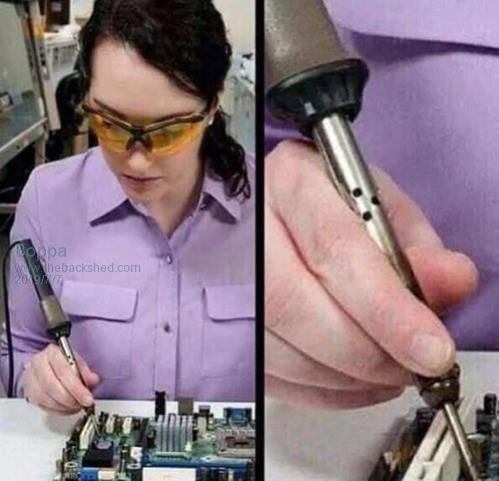 Um... I take it she's never used a soldering iron before LOL  (Love the 'safety glasses'- but wheres her asbestos glove???)  |
||||
Grogster Admin Group Joined: 31/12/2012 Location: New ZealandPosts: 9308 |
Fail.... Smoke makes things work. When the smoke gets out, it stops! |
||||
Madness Guru Joined: 08/10/2011 Location: AustraliaPosts: 2498 |
She is not even blonde     There are only 10 types of people in the world: those who understand binary, and those who don't. |
||||